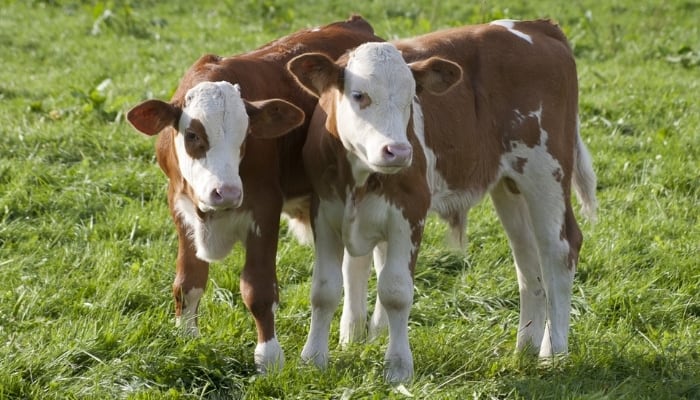Are you interested in adding a new type of cattle to your herd? Maybe you are thinking about buying your very first cow for your homestead?
Whether or not you know which type is best for you, it’s good to start with the costs.
How much are baby cows? Calves cost around $200 to $500 on average, though prices can vary significantly depending on cattle type (beef or dairy), breed, weight, age, health, and secondary factors such as the location the calf is sold, the time of year, and fluctuating market trends.
Not sure how dairy breeds differ from beef cows in terms of weight, feed, and market cost?
Don’t worry, we’ve outlined the prices of various breeds and included a breakdown of 10 factors that can determine the cost of the next calf joining your homestead.
Cost of a Calf: 10 Influences Factors
Various factors can impact the value of a calf with age and health having the heaviest bearing. Supply and demand in the state you buy from can vary things too. Let’s look at each consideration:
1. Age of Calf
Buying a day-old calf means bottle-feeding it for the next four months (which adds up when they drink 10% of their body weight in milk!).
On the flip side, the higher mortality rate of younger calves makes them cheaper at face value than more stable 5- or 6-month-old calves.
2. Breed of Calf
There are certain sought-after breeds of cattle, such as Texas Longhorn, Black Angus, and Red and White Holstein cows, with unique hides and characteristics that drive up prices, especially in areas of low availability.
3. Bull or Heifer Calf
Depending on breed and weight, heifer calves (females yet to have had a calf) may fetch $400-500 while a bull calf can be valued at twice this amount.
4. Pedigree of Calf
A calf that comes from superior stock with world-class genes and great earning potential is obviously going to drive up the price.
If a desirable calf breed has pedigree registration status, it is likely to be valued in the thousands.
5. Weight of Calf
All calves and cows are priced based on their weight, which is measured in hundredweight/per hundred pounds or “cwt” (centum weight).
According to a Farm Journal report, a bull calf’s value per CWT decreases as he gains weight.
6. Overall Health of Calf
Weaned and one-year-old calves are considered healthiest since they’re stronger and at an age where health problems are more identifiable.
Less-healthy calves (lame, sick, poor hair, etc.) are often heavily discounted.
7. Auction vs. Private Sale
Prices set by a private seller are entirely at their discretion and won’t always reflect the cow’s market value, but the commission and consignment fees of an auctioned animal can drive up sales prices.
8. Location
Calf costs vary depending on which state you’re in. The 2019 figures revealed general calf value to be three times higher in Texas than in Wisconsin and Montana.
Prices are also higher in rural areas that have a great distance between farming communities.
9. Time of Year
Demand is significantly higher for calves born in spring versus fall. This is because of lower feeding costs due to higher forage availability, so paying at peak times can save you money in the long run.
10. Current Market
Calf costs can slide depending on the current demand for a certain breed, and then there are unforeseen circumstances such as COVID-19, which can heavily disrupt the market.

Beef Cattle vs. Dairy Cattle: Average Calf Prices
On the whole, dairy calves tend to be cheaper than those raised for beef (with the exception of Jersey calves as they produce the creamiest, highest-quality milk for human consumption there is!).
Let’s look at what sets apart both cattle types and the average calf prices at market.
Difference Between Beef Cattle and Dairy Cattle
A typical beef calf can cost between $700 and $1,000 while dairy calves cost around half this amount in most cases.
However, the cost to raise either in terms of feed, water, land, and equipment used in beef and milk production comes out more or less even.
Dairy Cattle Breeds: Average Prices
Beef Cattle Breeds: Average Prices
Related Questions:
How Much Does It Cost To Raise a Cow Per Year?
The cost to raise a single cow per year can fall anywhere between $900 and $2,000 or more when you factor in feed, vet expenses, etc.
Annual costs depend on the breed and size of the animal. Dairy cows, for example, require more food in the winter than beef cattle to ensure their milk has enough nutrients.
How Much Does a Beef Cow Sell for at Auction?
An average mature beef cow may sell for around $1,500 to $5,000 at auction as prices depend largely on weight, breed, and the current market rate.
Beef cattle are sold at auction in hundredweight terms abbreviated as “cwt,” so a beef cow weighing 1,210 pounds priced at $157 cwt ($1.57/pound x 1,200) would sell for close to $1,900.
Conclusion
To sum up, dairy calves are cheaper on balance than beef calves, but many factors can influence the value of an individual calf from its age and health status to its breed, market trends, and whether you buy privately or at auction.
Whichever cattle type you envisage adding to your farm, we hope the above considerations have helped to inform your decision.

